The king penguin is considered to be the second-largest penguin species in the world, with the emperor penguin coming in first. Originally, it was believed that king penguins were the largest penguin species, which is why they were given the name “King.” In the 1800s, it was discovered that emperor penguins are actually a foot taller than king penguins. Various sub-Antarctic islands like Macquarie, Crozet, and many others are home to very large colonies of king penguins.
Today, we will be listing 10 incredible king penguin facts that will showcase how awesome and unique these creatures truly are!

1. King Penguins Have The Longest Breeding Cycle

King penguins take the prize of having one of the longest breeding cycles.
©Phil West/Shutterstock.com
Compared to many other penguins, king penguins take the prize of having one of the longest breeding cycles. These breeding cycles can last anywhere from 13 to 16 months. King penguins actually do not build nests but instead choose to incubate the eggs on top of their feet, with incubation lasting up to 60 days. Both male and female king penguins take shifts incubating the egg, usually with the father taking the first shift and the female heading off for food. Male king penguins will choose to abandon their egg if their body reserves aren’t enough to sustain them during that time.
2. King Penguins Are Often Mistaken For Emperor Penguins
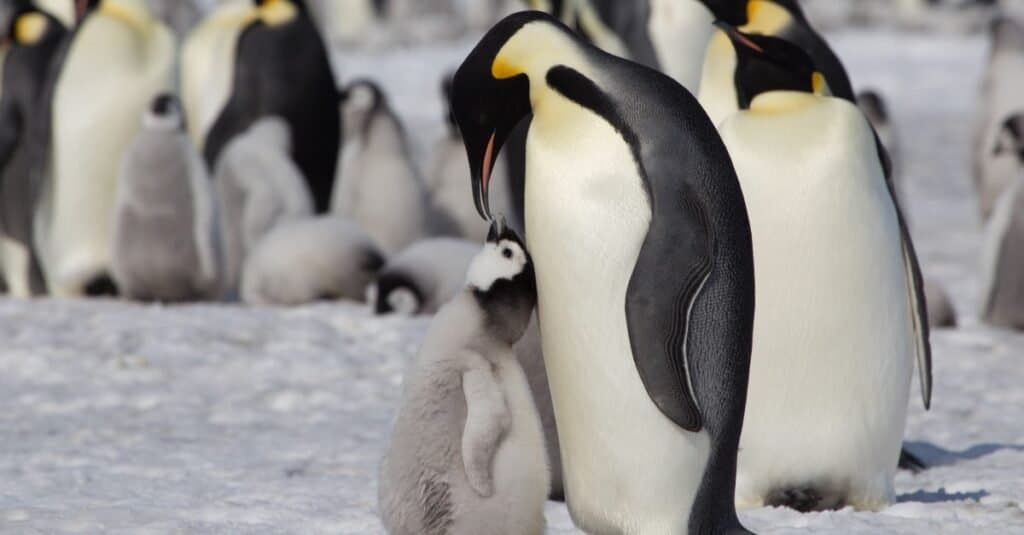
The emperor penguin is often confused with the king penguin due to close similarities in appearance.
©robert mcgillivray/Shutterstock.com
There is often confusion between king penguins and emperor penguins due to their incredible similarity and similar behavior. One way to distinguish between them is that king penguins have a very vivid orange coloring on their face and chest. Additionally, king penguins are slightly smaller, weighing between 25 and 35 pounds and standing between 2.5 and 3 feet tall. King penguins also have beaks that are narrow and longer than those of emperor penguins, along with an orange stripe on them.
3. King Penguins Are Incredible Hunters
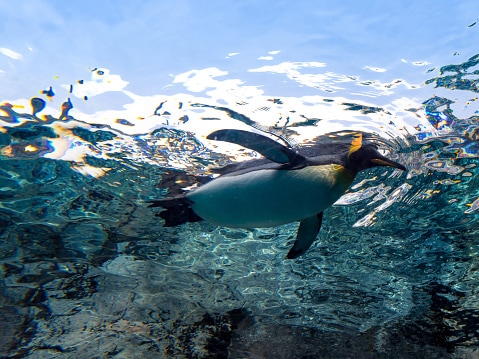
King penguins can dive to depths of 2,000 feet to hunt for krill, lantern fish, and other small fish species.
©nymphoenix/iStock via Getty Images
Another amazing king penguin fact is that they are incredibly prolific hunters and foragers. Since they have such large flippers, they can dive to depths that are below 2,000 feet to hunt for food. They enjoy eating lantern fish and many other small species of fish and krill. It is important to ensure that king penguins are careful when hunting in the water as there are many predators in the area, including sea lions, orcas, and leopard seals.
4. King Penguins Are Graceful Swimmers
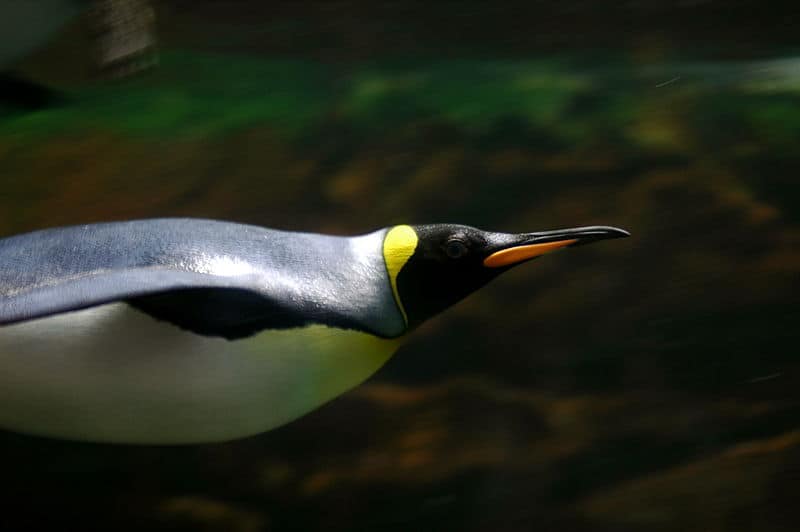
King penguins are incredible swimmers, reaching a maximum speed of 7.6 mph.
©Jeff Kubina from Columbia, Maryland, CC BY-SA 2.0, via Wikimedia Commons – License
Although not the fastest recorded swimmers for a penguin species, king penguins are still incredible swimmers; they can reach a maximum speed of 7.6 mph. King penguins have torpedo-shaped bodies that make them incredibly agile swimmers. As a result, their breast and wing muscles are specially designed to allow them to navigate through heavy and thick waters. One of the fascinating things to note is that king penguins can hold their breath for up to 20 minutes underwater!
5. King Penguins Are Monogamous

King penguins are monogamous for at least an entire breeding season, though some may not keep the same partner the following year.
©Ondrej Prosicky/Shutterstock.com
King penguins, like many other species of penguins, are monogamous. Throughout the breeding season, these penguins will only choose one mate to breed with. Together these two penguins will work together for the well-being of their offspring. Despite staying monogamous for the duration of the breeding season, some king penguins may not return to the same partner the following year. Instead, they will find a new one to breed with for the duration of that breeding season.
6. King Penguins Can Live Up to 40 Years in Captivity
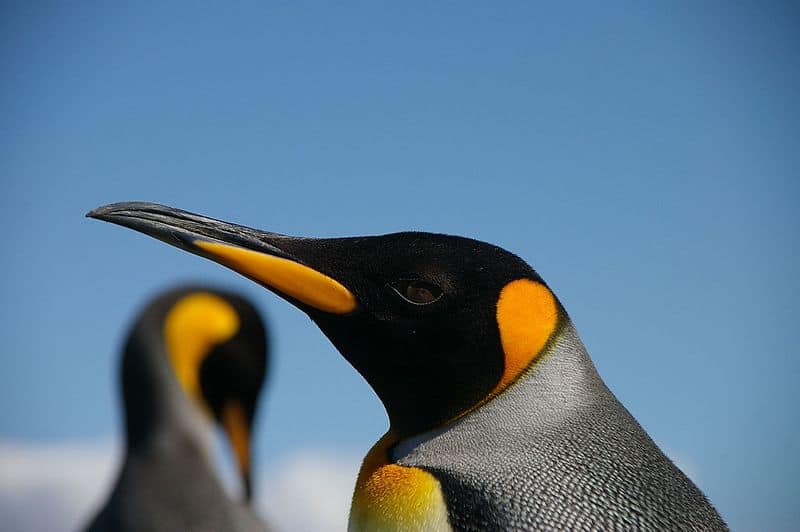
King Penguins live up to 25 years in the wild but can lengthen their lifespans by 15 years in captivity.
While king penguins in the wild can live up to 25 years, those in captivity live almost twice as long. As a result of climate change, penguin chicks are extremely vulnerable to danger and starvation. A recent study on king penguin lifespans examined the growth rate of small king penguin chicks. The growth rate of small king penguin chicks naturally exhibits a higher-than-normal growth rate throughout winter break as a consequence of the shortening of telomeres and oxidative stress. Small chicks that died early in the experiment had the shortest telomeres, the most serious oxidative damage, and the least antioxidant capacity. These results suggest that telomere length might be a good predictor of future survival.
7. King Penguins Are Designed With 4 Layers Of Feathers

The three innermost layers of the king penguin’s feathers are made up of thick feathers that allow them to incubate heat.
©fieldwork/Shutterstock.com
King penguins inhabit a harsh and cold climate, so it only makes sense that they have an incredibly designed thermal system to keep warm. The three innermost layers of the king penguin’s feathers are made up of thick feathers that allow them to incubate heat. The fourth layer of feathers is on the outside and is actually made with an oily waterproof coating. King penguin chicks are actually born without this oily waterproof coat which is why they cannot go swimming and hunting until they reach maturity and gain their adult plumage.
8. King Penguins Can Consume Salt Water

King penguins can actually consume salt water due to the unique design of their stomachs which filters the salt out throughout their bodies.
©Frank Günther/iStock via Getty Images
The water and ice throughout the Antarctic are incredibly salty. This makes it almost impossible for any animal to drink or hydrate. What makes king penguins so unique is that their stomachs are actually designed to separate the salt and filter it out throughout their body. This leaves them able to drink as much salt water as they want without becoming severely dehydrated.
9. King Penguins Come Ashore To Molt

Another fact about king penguins is that they come ashore annually to molt.
Another cool king penguin fact is that king penguins come ashore once a year to participate in a molt. This molt lasts about a month and is a very drastic time for a king penguin’s life. When they are molting, their feathers no longer remain waterproof, meaning they cannot participate in swimming to go feed. Their feathers also aren’t insulated anymore. While molting, king penguins also undergo a fast and can lose up to half of their initial body mass. This molting allows them to dispose of old feathers and create a whole new plumage.
10. King Penguins Are Incredibly Social
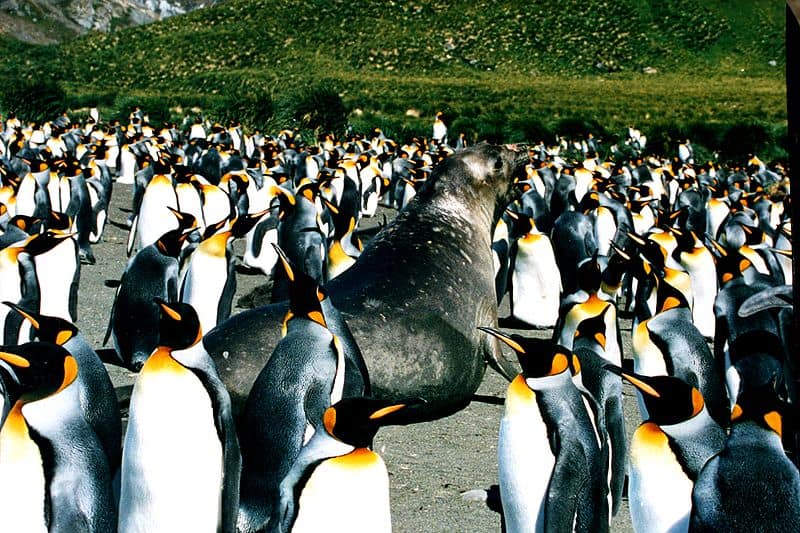
King penguins live in colonies with populations reaching as high as 39,000 breeding pairs.
King penguins are very social and curious creatures. Since they live in colonies, they are surrounded by hundreds of thousands of potential breeding partners and other penguins. Having colonies of this size allows them to create huddles where they can stay warm amongst each other. An incredibly interesting king penguin fact is that they also speak. They use incredibly unique vocalizations that help them distinguish one another when their mates return from foraging. King penguins are also very inquisitive of humans when researchers come to study them, and they come right up to them!
The photo featured at the top of this post is © fieldwork/Shutterstock.com
Thank you for reading! Have some feedback for us? Contact the AZ Animals editorial team.






